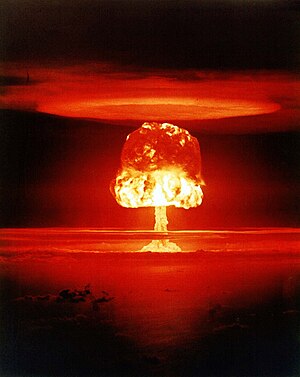 Image via WikipediaForty-five years ago today, the US Air Force suffered a real-life Broken Arrow when a hydrogen bomb was lost in a mid-air collision over rural Spain. The so-called Palomares Incident occurred on Jan. 17, 1966 when a KC-135 airborne refueling tanker collided with a B-52G bomber that was carrying four Mk28 hydrogen bombs. The entire crew of the KC-135 was killed, three of the seven men aboard the B-52G died, and all four hydrogen bombs separated violently from the destroyed aircraft.
Image via WikipediaForty-five years ago today, the US Air Force suffered a real-life Broken Arrow when a hydrogen bomb was lost in a mid-air collision over rural Spain. The so-called Palomares Incident occurred on Jan. 17, 1966 when a KC-135 airborne refueling tanker collided with a B-52G bomber that was carrying four Mk28 hydrogen bombs. The entire crew of the KC-135 was killed, three of the seven men aboard the B-52G died, and all four hydrogen bombs separated violently from the destroyed aircraft.This is a classic Broken Arrow event, wherein US-owned nuclear weapons are lost in a fashion that does not lead directly to nuclear war. (The film Broken Arrow actually depicts an Empty Quiver incident, wherein a nuclear weapon is stolen by hostile forces. The thieves attempt to disguise the theft as a mere Broken Arrow. The result is a Nuc Flash, as the stolen nuke is detonated.)
Two of the Palomares hydrogen bombs detonated their conventional explosive components upon impact with the ground, spreading plutonium fallout over a 2-square-kilometer area of Spain. A third bomb landed intact in a riverbed. The fourth bomb was lost when its descent parachute miraculously deployed after the collision, allowing the weapon to drift into the Mediterranean Sea.
It took nearly three months for a massive naval expedition to locate what was a essentially a metal cylinder 22 inches wide by 170 inches long in the vast expanse of the Mediterranean. Fortunately, the US Navy had some serious math geeks around to help them increase their odds of tracking down the nuclear needle in the aquatic haystack.
What geekworthy technique was used to locate the lost Palomares hydrogen bomb?
The US Navy used Bayesian search theory to track down the lost Palomares nuclear weapon.
For those unfamiliar with the technique, Bayesian search divides a search area into a grid, then assigns the probably of finding the target within each gridsquare. Not the probability of the target being present in the gridsquare, but of it being located. In extremely deep water, for example, the weapon was considerably more difficult to find than in shallow depths. After searching a gridsquare, the probability of the target being present there drops dramatically, but doesn't become zero. After searching each gridsquare, the probability of every gridsquare is recalculated. Bayesian search theory thus constructs a search pattern that guides searchers from the area where the target is most likely to be found to where it is least likely, constantly updating to improve the odds of a successful location and thus minimizing time spent searching.
When you're hunting for a lost hydrogen bomb, you want to take as little time as possible. Despite the Bayesian assist, it still required 20 surface ships, four submersibles, and 150 divers nearly three months to locate and recover the bomb. It also took multiple salvage attempts -- and an assist from the famous Alvin DSV -- to raise the nuke from a submerged depth of 2,900 feet.
The hydrogen bomb was fully intact and resides today at the National Museum of Nuclear Science and History in Albuquerque, New Mexico. That's not just the proud product of the some prodigious probabilistic pondering, but an atomically astounding act of the Truly Trivial.

No comments:
Post a Comment